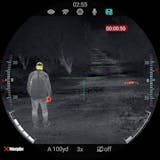Ever gazed into the darkness and wished you could see what lurks beyond? Well, your wish might be about to come true. The world of night vision and thermal optics is undergoing a major transformation, pushing the boundaries of what’s possible and promising a whole new way of seeing the world, especially when the sun goes down.
Beyond the Basics: The Evolution of Night Vision
Forget the grainy green images of old. Modern night vision technology is a far cry from those early clunky devices. We’re talking about high-resolution, crystal-clear images even in near total darkness. Thanks to advancements in image intensifiers, low-light sensors, and digital processing, night vision has become more affordable, more accessible, and more versatile than ever before.
The Power of Image Intensifiers
Image intensifiers are the heart of most night vision systems. These devices amplify available light, even in extremely low-light conditions. They work by converting photons (light particles) into electrons, multiplying those electrons, and then converting them back into photons. The result is a brighter image, allowing you to see in the dark.
Digital Enhancement: A Game Changer
Digital processing techniques are revolutionizing night vision. Advanced algorithms are used to enhance images, reduce noise, and improve clarity. These advancements are leading to night vision systems that produce images that are remarkably close to what the human eye would see in daylight.
Thermal Imaging: Seeing the Heat
Thermal imaging takes things to a whole new level. It doesn’t rely on light to work, instead, it detects and visualizes infrared radiation (heat) emitted by objects. This means that thermal imaging can see through fog, smoke, and even foliage, providing a clear picture even in the most challenging conditions.
The Science Behind Thermal Imaging
Every object, whether living or inanimate, emits heat. Thermal imaging systems are designed to detect this heat signature and convert it into a visual image. Different temperatures are displayed in different colors, allowing you to distinguish between objects based on their heat output.
Where does thermal imaging excel?
* **Security & Surveillance:** Thermal cameras are becoming essential tools for law enforcement, security personnel, and even homeowners, allowing them to detect intruders and potential threats in the dark. Imagine a thermal camera spotting a person hiding in the bushes or a suspicious vehicle approaching a building - it's like having a pair of heat-seeking eyes in the night. * **Wildlife Monitoring:** Scientists use thermal imaging to study animal behavior, track endangered species, and monitor wildlife populations. Think about tracking a pack of wolves in a dense forest or studying the migration patterns of birds. Thermal imaging makes these tasks easier and more effective. * **Search & Rescue:** In disaster relief situations, thermal imaging can locate victims trapped in rubble or lost in the wilderness. In the aftermath of an earthquake or a forest fire, thermal imaging is crucial for finding survivors quickly. * **Medical Applications:** Thermal imaging is used to diagnose conditions like inflammation, infections, and even cancer. It allows medical professionals to see the body’s heat distribution, which can help identify abnormalities and monitor treatment progress.
What's on the Horizon?
The future of night vision and thermal optics is bright. Here are some of the exciting developments to watch out for: * **Miniaturization:** Expect to see smaller, lighter, and more portable devices that can be easily integrated into everyday items like smartphones and drones. Imagine a pair of glasses with built-in night vision that allows you to navigate the city streets at night or a drone equipped with a thermal camera for search and rescue operations. * **Artificial Intelligence Integration:** AI algorithms are being used to enhance image processing, making night vision and thermal images even clearer and more detailed. AI can help identify objects in the dark, track moving targets, and even provide real-time analysis of what's being seen. * **Augmented Reality:** AR technology is being combined with night vision and thermal optics to create immersive experiences that overlay real-world images with additional information. This could lead to devices that display crucial information like the location of people, objects, or even potential dangers. * **Advanced Materials:** New materials are being developed that improve image quality, extend battery life, and enhance durability. Imagine night vision goggles that are more resistant to harsh environments or thermal cameras that can operate for longer periods without needing a recharge.
Beyond the Battlefield: The Wider Impact
Don't just think of night vision and thermal optics as military tech. These technologies are finding applications in a wide range of industries: * **Automotive:** Driver-assistance systems are being equipped with night vision cameras to enhance safety at night. These systems can alert drivers to pedestrians or animals in the road, even in low-light conditions. * **Construction:** Thermal imaging helps detect structural defects and monitor energy efficiency. Inspectors can use thermal cameras to identify leaks, insulation problems, and other potential hazards in buildings. * **Agriculture:** Farmers use thermal imaging to monitor crop health and optimize irrigation. Thermal imaging can help farmers identify stressed crops, monitor water usage, and optimize resource management. * **Law Enforcement:** Thermal cameras are being used for various applications, including search and rescue, surveillance, and crime scene investigations. They allow officers to identify individuals in the dark, track suspects, and even locate evidence.
The Future is Now
The future of night vision and thermal optics is exciting, and it's happening right now. As these technologies continue to advance, they will become even more integral to our lives, offering unprecedented capabilities for seeing the world in a whole new light, day or night.






